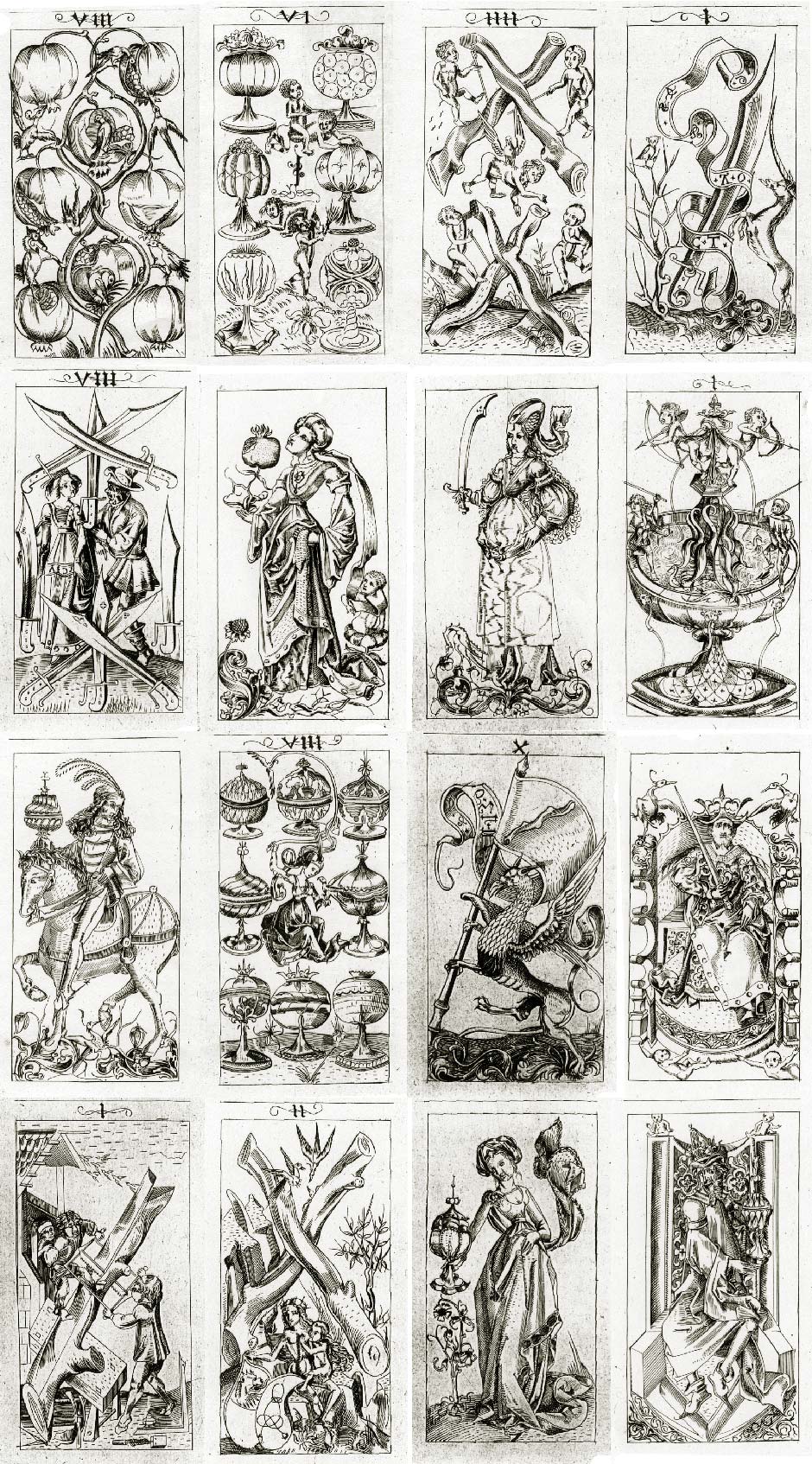South German Engraver
A pack of 52 cards with banner 10s, female 'Sotas', horsemen and kings, the pack was engraved in the new Plateresque style for a royal wedding.

A craftsman known as the “South German Engraver” produced this elaborate Plateresque (in the manner of the silversmith) interpretation of the Spanish-suited pack which appears to commemorate the marriage, in 1496, of Felipe I of Spain and Doña Juana, daughter of Ferdinand and Isabella. The Plateresque artistic movement was popular amongst the ruling classes of Imperial Spain, following the Reconquista and the beginning of the colonisation of the Americas, but was usually applied to architecture.
Sometimes referred to as Schongauer's follower, the engraver worked the same way as most of his colleagues of the time: he copied and re-worked other engravers, as well as other playing cards and popular images. Some of the court figures have been adapted from other sources where they might have held a falcon rather than the present suit symbol.
(Click here to see enlargement and engraver's monogram)

The pack conforms to an archaic format of 52 cards with numeral cards running from 1 to banner 10s, female 'Sotas' or maids (not queens), cavaliers and kings. A number of other packs with similar characteristics survive elsewhere. As can be seen, these late gothic playing cards are decorated - not quite 'transformed' - with birds, animals, plants, children and other miniature creatures. The suit sign of pomegranates probably alludes to the recently reclaimed kingdom of Granada. Several original examples of this pack are known, although none are coloured, and facsimile editions have also been produced.
A sheet with facsimile illustrations of nine cards appeared in Johann Gottlieb Immanuel Breitkopf’s “Ursprung der Spielkarten”, 1784.

Above: a facsimile copy published by Johann Gottlieb Immanuel Breitkopf, Leipzig, 1784. © The Trustees of the British Museum • number 1896,0501.1431►
Breitkopf’s “Ursprung der Spielkarten” (Attempt to research the origin of playing cards, the introduction of linen paper and the beginning of woodcutting in Europe), Leipzig, 1784, can be consulted online here►
See also:
The Upper Rhine Master of the Banderoles Early German Engraved Cards Gothic Spanish-suited Playing Cards Ambras Hunting Pack The Stuttgart Pack History Hunting Germany Spain Italy Portugal Master of the Playing-Cards Master PW Circular Playing Cards.

By Simon Wintle
Member since February 01, 1996
I am the founder of The World of Playing Cards (est. 1996), a website dedicated to the history, artistry and cultural significance of playing cards and tarot. Over the years I have researched various areas of the subject, acquired and traded collections and contributed as a committee member of the IPCS and graphics editor of The Playing-Card journal. Having lived in Chile, England, Wales, and now Spain, these experiences have shaped my work and passion for playing cards. Amongst my achievements is producing a limited-edition replica of a 17th-century English pack using woodblocks and stencils—a labour of love. Today, the World of Playing Cards is a global collaborative project, with my son Adam serving as the technical driving force behind its development. His innovative efforts have helped shape the site into the thriving hub it is today. You are warmly invited to become a contributor and share your enthusiasm.
Related Articles

Pierre Varangot
Tracing the origins, legality and legacy of Pierre Varangot’s San Sebastián deck.

Archaic Spanish-suited pattern from Bayonne
Archaic Franco-Spanish pattern from Bayonne by a manufacturer with the initals M.V.

Shin-Tōmei Expressway Opening Commemoration
Promotional playing cards for the Shin-Tōmei Expressway, a major Japanese expressway that opened in ...

CARD-AB Miltenberg
Illustrations by Rita Stern depicting notable landmarks and scenes from the town of Miltenberg in Ge...

New Altenburg Skat cards – German DDR Pattern
Authentic Altenburger Skat cards with German suits (Acorns, Hearts, Leaves, Bells).

German Travel Cards
A travel-themed educational deck helping American tourists visiting Germany.

French Revolutionary cards by Pinaut
Seven cards from a French Revolutionary pack by Pinaut featuring characters from classical antiquity...

An Anonymous Belgian Transformation Pack
Anonymous Belgian transformation pack borrowing many images from earlier designs by Braun & Schneide...

Tarot de las Coscojas
Historical playing card design, tarot symbolism and an almost psychedelic medieval surrealism.

Tarot de Valverde de la Vera
A series of 24 surrealist engravings by Mexican artist Claudio Favier in which archetypal Tarot alle...

Songs with Flute accompaniment
Eighteenth century English engraved cards with music for voice and flute.

Briefmarken-Quartett
Quartet game featuring postage stamps from the Zones of Occupation in post-WWII Germany.

Le Globe Céleste
Views and plans of five international exhibitions held in Paris between 1855 and 1900.

IG Chemie Papier Keramik
Promotional pack designed by Karl-Heinz Schroers for a German trade union with comical bears on the ...

Baraja de Juan Martín Zamorano
Deck inspired by El Pendón de los Zamorano, a military pennant dating from 1501, published by Priego...

Heráldica Castanyer No. 16
Strange variant of international pattern cards for poker or bridge.
Most Popular
Our top articles from the past 28 days

